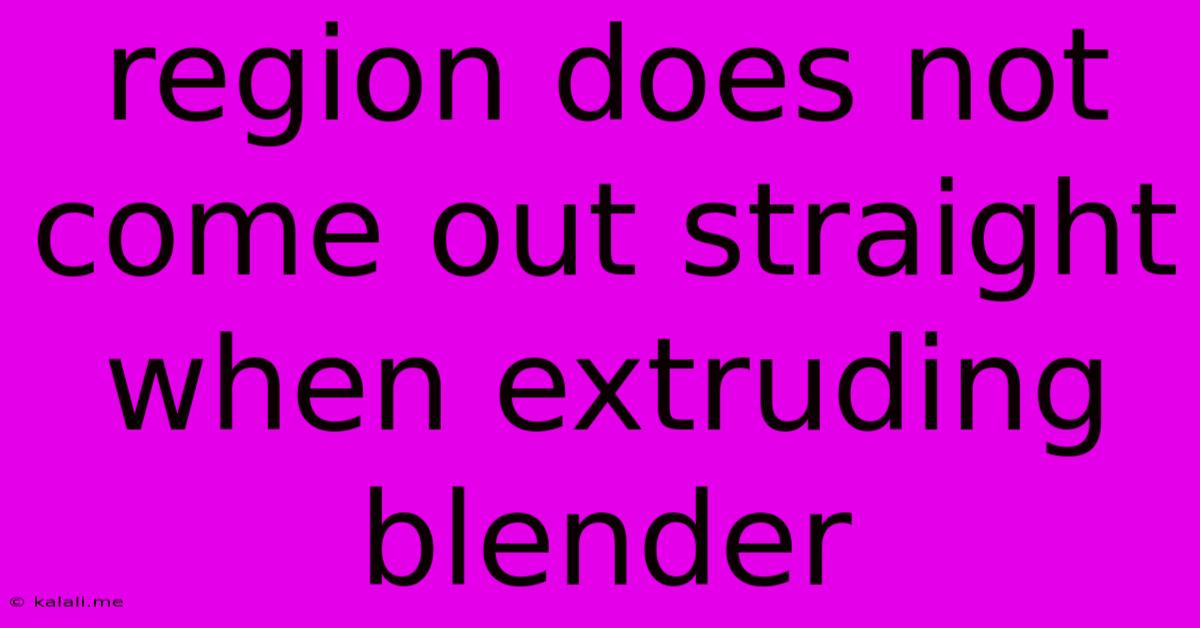Region Does Not Come Out Straight When Extruding Blender
Kalali
May 31, 2025 · 3 min read

Table of Contents
Why Your 3D Prints Aren't Straight: Troubleshooting Extrusion Problems in Blender
Are you struggling with wobbly, uneven, or otherwise imperfect 3D prints coming out of your Blender projects? A common culprit is extrusion issues, leading to a region that doesn't print straight. This frustrating problem can stem from several sources within your Blender workflow. This article will guide you through troubleshooting these issues and getting your prints back on track.
Common Causes of Crooked Extrusions:
Several factors can contribute to your 3D print's imperfect geometry. Let's delve into the most frequent offenders:
1. Mesh Problems: The Foundation of Your Print
-
Non-Manifold Geometry: This is a significant cause of extrusion problems. Non-manifold geometry refers to areas in your mesh where faces share edges incorrectly. Think of it as a glitch in the mesh's structure. Blender often struggles to properly interpret these areas, resulting in unpredictable extrusion behavior. Use Blender's tools to identify and fix these issues. Look for overlapping faces or inconsistencies in the model's topology.
-
Improper Scaling: Scaling your model incorrectly can lead to skewed proportions and unpredictable extrusion patterns. Ensure your model is scaled correctly before exporting for 3D printing. Check your units and dimensions to ensure consistency.
-
Inconsistent Thickness: Uneven thickness throughout your model can create areas where the extruder struggles to maintain a uniform extrusion width. Aim for consistent thickness, especially in areas where straight lines are crucial.
2. Modifier Issues: Affecting Your Model's Shape
-
Incorrect Modifiers: Modifiers are powerful tools but can sometimes cause unforeseen problems. Double-check your modifiers, especially those affecting the geometry such as Subdivision Surface, Mirror, or Array modifiers. Ensure they are correctly applied and not causing unexpected distortions. Pay particular attention to how they affect the final mesh before exporting.
-
Modifier Order: The order in which modifiers are applied is crucial. Incorrect order can lead to unexpected results. Experiment with the modifier stack to find the optimal order.
3. Export Settings: Bridging the Gap Between Blender and Your Printer
-
STL Export Issues: Problems during the STL export process can also cause extrusion inconsistencies. Make sure your export settings are correct; a lower polygon count might be causing issues. Try experimenting with different export settings to find an optimal balance between file size and detail. Also, ensure your model is properly scaled and oriented in the export settings.
-
Slicer Settings: Even with a perfect model, improper slicer settings can ruin your print. Incorrect extrusion width, temperature settings, or print speed can all contribute to uneven or distorted extrusions. Consult your slicer's documentation for optimal settings for your specific printer and filament type.
4. Printer-Specific Issues: Hardware and Software Troubles
-
Nozzle Clogging: A clogged nozzle is a major culprit. Ensure your nozzle is clean and free from obstructions.
-
Inconsistent Extrusion: Uneven filament feeding can lead to inconsistencies in the extrusion. Check your filament feed mechanism to ensure it's working correctly.
-
Bed Adhesion: Poor bed adhesion can lead to the print lifting and warping, giving the appearance of uneven extrusion. Ensure proper bed adhesion by using glue stick, tape, or other adhesion aids.
Troubleshooting Steps:
- Inspect your mesh: Thoroughly examine your mesh for any non-manifold geometry, holes, or inconsistencies.
- Check your modifiers: Ensure your modifiers are correctly applied and in the right order.
- Export as an STL: Use a high polygon count for better accuracy.
- Examine your slicer settings: Adjust your extrusion width, temperature, and print speed.
- Clean your nozzle: A clogged nozzle is a common problem.
- Check your filament feed: Ensure consistent filament feeding.
- Improve bed adhesion: Ensure your print adheres well to the bed.
By systematically working through these steps and addressing potential problems in your model, your modifiers, export settings, and printing process, you can significantly improve your 3D printing results and finally achieve those perfectly straight regions. Remember, patience and persistence are key!
Latest Posts
Latest Posts
-
Mac Change Password On External Hard Drive
Jun 01, 2025
-
Wheres The Admin Data Located In Wp Mysql Php
Jun 01, 2025
-
Does The Washer Go On The Nut Side
Jun 01, 2025
-
Find Resistor Combination To Create Ar Esistance
Jun 01, 2025
-
How Long Does A Alignment Take
Jun 01, 2025
Related Post
Thank you for visiting our website which covers about Region Does Not Come Out Straight When Extruding Blender . We hope the information provided has been useful to you. Feel free to contact us if you have any questions or need further assistance. See you next time and don't miss to bookmark.